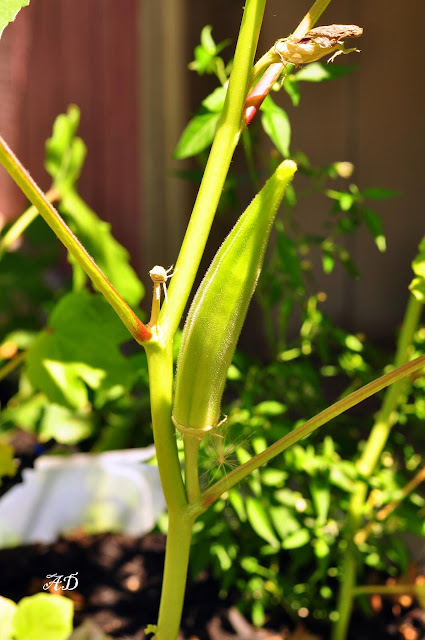21st July 2013, status of our organic farming experiment
Kale: So by now we have started getting vegetables for cooking from our back yard garden, the most productive has been Kale, very easy to grow, no bug problem and very fast growth rate. We bought 4 of these kale plants in one pot from Walmart and planted in one patio picker box and watered regularly. It has been one of the healthiest plant in our garden.
 |
| Our Kale plant growing in a planter box. |
 |
| Roma Tomato plant, one tomato starting to turn red now. |
Tomatoes: We have 4 plants of Roma tomatoes, one hybrid tomato and two plants of cherry tomatoes, all in containers. They are extremely productive, there are around 50 tomatoes altogether between the 4 Roma tomatoes and one hybrid tomato plant, number of cherry tomatoes between two plants is probably 30-40. It takes a while for the tomatoes to become ripe and turn to red color, now we have our first two Roma tomatoes turning red. We have not had any bug problems with our tomato plants. They need a lot of space to grow. One helpful thing we did was build a cage around the tomato plants initially to support them and protect them during heavy winds of pacific northwest, later when the plants started giving tomatoes, the plant intelligently started using the cage for support and often it was seen the plant branches without support drops down due to the weight of the tomatoes. We kept adding more and more fence around the tomato plants so that they can get support. The plants grew through the fence, enforcing the supporting structure.The fence we used was a cheap wire
fence for garden that was bent and connected to each other, so we improvised in this manner because our rectangular pots were not ideal for a circular tomato cage.
 |
| Roma Tomatoes another tomato that is almost red already among some 40 which are still green. |
|
 |
| Cherry Tomatoes |
 |
| Cherry Tomatoes, they grow very well with no bug problems |
 |
| Hot pepper that grows very well, not much hot actually though |
Chilly: We have one jalapeno plant, one hot green pepper plant, one capsicum plant and one thai pepper plant in the containers in our garden. Initially for some time they were flowering and the flowers became dry and fell off, then in few weeks new flowers came which started turning into pretty big chilies. They grew pretty fast. The capsicum plant didn't have issue of flowers wilting, the first two flowers itself turned into capsicum. We have already harvested a few hot peppers and a few jalapenos from our garden for cooking. Jalapenos were spicy, hot peppers were surprisingly not at all spicy, the hot thai pepper started giving chilies recently, we are hoping that it will stand up to our "hot" expectations. We didn't have any bug problem with our chilies either.
 |
| Hot pepper almost grown to full size. |
 |
| Hot Thai Pepper, about 7 of them have started growing now, these are expected to be really hot. |
 |
| Jalapenos, reasonably hotter than what we get in market. |
Egg plant (Brinjal): We have only two egg plants in our garden. One is a black beauty egg plant that grows to the fat, big egg plants and a japanese egg plant that makes these long thin egg plants. Both of them were very slow during growth and also the flowers were drying and falling of for several weeks, now since last few weeks we have started seeing many egg plants in the japanese egg plant, almost 7 of them are growing now and have reached almost 4 inches or so in length. In the black beauty egg plant two of them have started growing. One is about two inches long. Both of them are dark violet in color.
 |
| Black beauty egg plant, the big fat egg plants. |
Zucchini: We bought 3 zucchini plants and planted them in one big planter. They grew very fast, now we have about 6 zucchinis growing slowly.
 |
| Zucchini plant with numerous green zucchinis all around the plant. |































